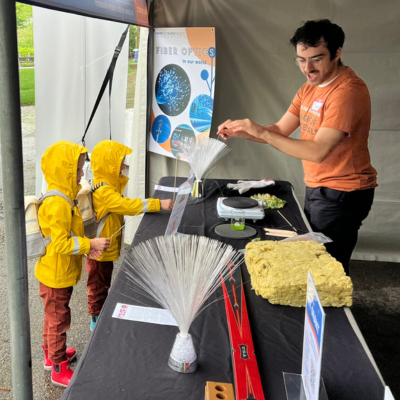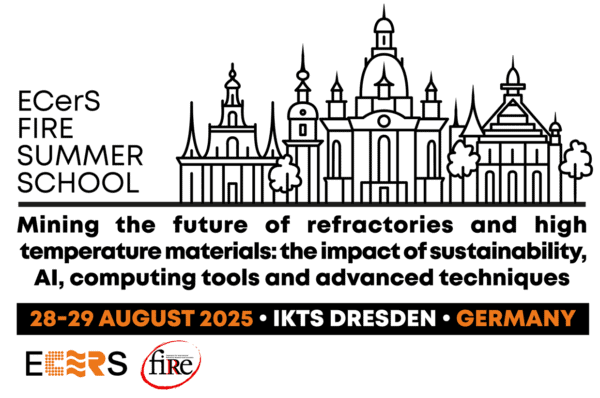
It’s summer vacation and you’re 15 years old, excited to take a break from school and go to a sports camp with your friends. But mom has different plans and sends you to a science camp at a local college. Moping around on your phone, daydreaming about sports camp—until the sound of breaking glass catches your attention in the science lab.
This is just one reaction that Dr. Casey Schwarz witnessed during the 2019 Glass and Materials Science (GaMES) summer camp at Ursinus College in Collegetown, Pennsylvania. The breaking glass was a part of a thermal shock experiment that Schwarz uses in her outreach efforts.
“Not everybody, not (all) high schoolers know what materials sciences is, and just giving them this idea of this is a job that people get, or this is a science people can go into, I think that’s important,” Schwarz says.
Schwarz hadn’t always worked with younger students, though.
“I didn’t even see that as an option because I saw, ‘Okay, well, you can work at a university and have a research lab, or you can go into industry,’” Schwarz says.
After earning her Ph.D. in physics at UCF in 2012, Schwarz continued to conduct postdoctoral research. It was then that she began working with undergraduates and dabbling in teaching. Now, Schwarz works as a materials scientist and an assistant professor of physics at Ursinus where she teaches undergraduate students.
“These students are just figuring out what they want to do and what they’re interested in,” Schwarz says. “And then that just kind of gets extended into, well there’s also high schoolers that are interested the same way. And then how can we make this accessible to even younger students that we work with?”
Schwarz figured out how to do just that in the summer of 2019 after receiving a grant from the Ceramic and Glass Industry Foundation (CGIF). This grant served as funding for 10 materials science classroom kits from CGIF and for a student assistant to help Schwarz develop a summer camp based on glass and materials science aimed at 9 to 15-year-olds. The thermal shock experiment is one of nine demonstrations included in the CGIF classroom kit.
The GaMES camp aimed to serve underrepresented students in the local area.
“We were looking for diverse applicants, people who might not be going to any kind of summer camp, just getting kids aware of materials science at a very young age,” Schwarz says.
GaMES included student camp counselors, guest speakers, and demonstrations featuring other Ursinus professors. Quentin Altemose, a graduate assistant who helped Schwarz develop GaMES, also collaborates with her on various projects.
“The main objective of GaMES was to create an environment where students who otherwise may not have opportunity to experience the hard sciences…would be able to foster an interest in the sciences, ideally in physics, but in any of the STEM realms,” Altemose says.

Combining science with fun, GaMES held contests to see who could draw out the longest, string-like candy fiber from a beaker of melted hard candy with a wooden stick. This demonstrates what a glass fiber looks like without actually using any glass.
The camp was a major success in the area, as Schwarz notes that many younger siblings—dubbed as “The Littles” by the team—tagged along. Overall, Schwarz found that GaMES helped the children garner more interest in general science.
“More of them saw themselves as being someone who could do science and who had learned these kinds of things,” she says. “I had a ton of parents contact me and said that they wanted to do it again.”
Due to COVID-19, GaMES has remained in 2019 as a standalone event, but Schwarz plans to revive it in the future as a yearly event once the Ursinus campus deems it safe again.
In the meantime, Schwarz forges ahead with other means of outreach. With the help of Altemose and CGIF, Schwarz is currently working on producing a glass-only materials science kit.
While the glass-only kit is still in the works, Casey Schwarz also makes time to visit her sibling, Mx. Jenna Schwarz, in Florida where they teach fourth graders at Calusa Elementary School. Jenna Schwarz first heard about the CGIF kits from Casey Schwarz and has been able to use them in their classroom with the help of grant funding.
“The students loved the hands-on projects,” Jenna Schwarz says. “The projects led to real world discussion and furthered their excitement of science. Students wanted to go home and research more in-depth information as a follow up project based on the project they did for the day. Students expressed their interest in science and how they can pursue science in the future.”
Casey Schwarz finds this to be true in her own outreach efforts like GaMES, in addition to realizing the importance of having students make real-world connections to science that they can see and touch.
“We always try to make that connection to real things because materials are everywhere,” Schwarz says.
Although her outreach efforts in the science realm remain mostly in Pennsylvania and Florida for now, Schwarz still fosters lasting relationships and leaves a profound impact on the people she works with.
“Casey is undoubtedly the best academic, professional and personal mentor I could have had,” Altemose says. “She has made a profoundly positive impact on my life and my trajectory in ways that I really couldn’t even describe…Whether it’s outreach to local high schools, disadvantaged groups, speaking at seminars or events, or even just helping the students, her door’s always open. She’s really quite fantastic.”
Inspiring people is something that Schwarz does time and time again with her outreach efforts.
“You don’t know how influential you can be, just like the feeling of showing somebody (anything) for the first time…there’s all these little firsts that could spark something, some kind of imagination,” Schwarz says.
Schwarz views science the same way many young students do.
“It’s all playing. I mean, that’s all it is,” Schwarz says. “We’re not testing them or anything. So it’s just like, play around with some material you know, really have fun with it. That’s what science is about.”
Help us continue to inspire the next generation of ceramic and glass professionals. Give now at ceramics.org/donate.



Categories
- Feature Stories
- Materials Science Kits
- Project Grants
- Student Outreach


